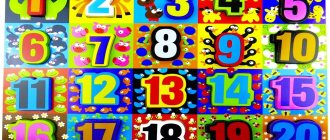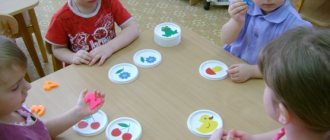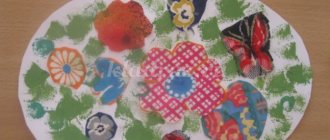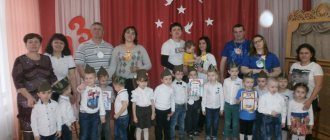Summary of a lesson on FEMP in the middle group using multimedia support
“Journey to the land of geometric shapes” Lesson on FEMP in the middle group using multimedia accompaniment.
Author: Likhovskikh Ruzigul Gardulloevna teacher of the KGKOU orphanage 18 p. Otradnoye, Vyazemsky district, Khabarovsk Territory. Description: When working with children, the use of multimedia technologies (color, graphics, sound, modern video equipment) allows me to simulate various situations, activate the cognitive activity of students and enhance the assimilation of material. The use of information technology in a preschool educational institution is possible and necessary; it helps to increase interest in learning and develops the child comprehensively. The clarity of the material increases its absorption, because All channels of perception of children are involved - visual, mechanical, auditory and emotional. The use of multimedia accompaniment in mathematics classes ensures the activity of children when examining, examining and visually identifying the signs and properties of objects; methods of visual perception, examination, and identifying qualitative, quantitative and spatio-temporal signs and properties in the objective world are formed. The formation of elementary mathematical concepts occurs on the basis of the construction and use of visual models by children. The use of new unusual methods of explanation and reinforcement, especially in a playful form, increases children’s involuntary attention and helps develop voluntary attention. Information technology provides a person-centered approach. Program tasks : 1. Familiarization with volumetric geometric shapes; 2. the ability to compare objects by size, distinguish between three-dimensional and flat geometric shapes; cube, cylinder, cone, etc. square, triangle, circle, etc. 3. Formation of visual perception, examination, identification of qualitative, quantitative and spatio-temporal signs and properties in the objective world. 4. Development of visual attention and visual memory. 5. Replenishment of vocabulary. 6.Cultivate an interest in mathematics and a desire to work in a team. MATERIALS FOR THE CLASS ;
Demonstration; educational video “Chuk-Chuk the train and geometric shapes” Handout; volumetric, plastic geometric shapes (you can make shapes from paper); A-4 sheets of paper, pencils. Progress of the lesson
- Guys, today we, together with the little engine Chukh-Chukh, will go on a journey to the land of geometric shapes, the journey will be interesting and exciting. And you look carefully and try to remember everything that the train will show you. - So, let's begin our journey... - Did you like the journey with the Chukh-Chukh train? - Now let's see how attentive you were during the trip. - Please note that in front of you there are geometric figures the same as those transported by the train. - Show and name the figures that the Chukh-Chuk train transported? (cube, cuboid, pyramid, cone, cylinder, ball, torus, prism) - What are all these geometric shapes called and why? (three-dimensional figures, because they have volume, i.e. they take up space in space). - Let's see what happens if we trace the base of each volumetric figure on a sheet of paper. What are the names of the figures drawn on paper? (flat figures; cube-square, cuboid-parallelepiped, pyramid-square-triangle-polygon, cone-circle, cylinder-circles, prism-triangle-polygons). — Please show me the pyramid and the cone. What is the difference? (a pyramid has a base of a square, a rectangle, a triangle, a polygon, and a cone has a base that is always a circle and has no edges). - What are their similarities? (both the pyramid and the cone have a base and an apex). - Who will show me the ball? How is he different from all the figures? (the ball has no base, corners, sides). —What types of prisms are there? (triangular, polygonal), why are they called that? (because they are based on a triangle, polygons). - Well done guys, today you were attentive and learned to distinguish three-dimensional geometric shapes. Now you can play with the figures, build houses, a palace, gates and other buildings. Fantasize yourself.
We recommend watching:
Summary of a comprehensive lesson on FEMP with elements of application in the middle group. Summary of a lesson in mathematics in the middle group of kindergarten. Synopsis of a game-based cognitive lesson on FEMP in the middle group. Synopsis of joint activities on mathematical development for children of the middle group.
Similar articles:
Math lesson “Rectangle” in the middle group of kindergarten
Mathematics lesson “Ordinal counting” in the middle group
Progress of the lesson:
Part I. Game "Find the extra piece "
.
The teacher one by one shows the children cards depicting geometric shapes (circle, square, triangle), invites them to look at them and asks: “How are the shapes ? How are the shapes ? Which shape is the odd one out ? Why?”
Part II. Game "Build a figure "
.
Each child has 4 red and 3 green sticks and a string.
The teacher gives the task: “Make a square from red sticks. Show him his sides. Make a circle out of string. Circle it with your hand. Make a triangle out of green sticks. Show its sides and corners."
Part III. Game "Wonderful bag"
.
The teacher recites the quatrain:
I am a wonderful little bag, I am a friend to all the guys. I really want to know how you like to play.
In a “wonderful bag”
there are large and small cubes and balls of different colors.
Children identify geometric shapes by touch , then take them out and name the colors.
Educator: What geometric shapes did we repeat ? Thanks to all. Well done everyone!
Abstract of the GCD for FEMP “Journey to the fairy-tale land of geometric shapes” in the second junior group Tasks: - exercise children in counting within 5; - consolidate knowledge of quantitative and ordinal calculations; - consolidate the idea of.
Synopsis of GCD for FEMP in the second junior group “Geometric Figures” SUMMARY OF GCD FOR EDUCATIONAL FIELD “COGNITION. FEMP" in the second junior group No. 5 FINAL LESSON "GEOMETRICAL FIGURES: CIRCLE, SQUARE,.
Abstract of educational activities on FEMP in the second junior group “Geometric figures” Topic: “Geometric figures” Target guidelines: the child correctly determines the quantitative ratio of two groups of objects; understands.
Summary of an open lesson on FEMP in the middle group “Geometric Figures” Topic: “Geometric Figures”. IOO: cognition, communication, socialization, reading fiction. Types of activities: gaming,.
Notes on FEMP in the second junior group “Journey to the land of geometric shapes” Goal: Improve the ability to distinguish and name geometric shapes (circle, square, triangle) Educational objectives: - consolidate.
Summary of the FEMP lesson “Quarrel of geometric figures” for the second junior group Formation of elementary mathematical concepts Topic “Quarrel of geometric figures Tasks: continue to introduce the parts of the day: day,.
Notes for a lesson on FEMP in the junior group “Geometric Figures” Notes for a lesson on FEMP in the junior group “Geometric Shapes” Goal: To improve the ability to distinguish and name geometric shapes:.
Summary of a mathematics lesson in the second junior group using Dienesh's blocks “Country of Geometric Shapes” “Dienesh's Blocks” Dienesh's logical blocks help the child master mental operations and actions that are important both in terms of pre-mathematics.
Summary of the lesson on FEMP in the second junior group “Geometric Figures”
Irina Dudina
Summary of a lesson on FEMP in the second junior group “Geometric Figures” Improve the ability to distinguish and name
geometric figures : circle, square, triangle, ball, cube.
Goal: strengthening the ability to distinguish and name geometric shapes , the main characteristics of objects: color, shape, size.
1) consolidate the ability to distinguish and name the ball (ball)
and cube
(cube)
regardless of the color and size
of the figures ;
2) develop the ability to distinguish objects of contrasting size, using the words big, small; distinguish the number of objects using the words one, many, none;
3) cultivate friendly relationships between children and interest in activities .
Didactic visual material
Demonstration material. Three cards depicting geometric shapes (a circle, a triangle, a green square, a blue circle; three circles of different sizes in yellow, a yellow triangle, a large yellow circle; a small red circle, a large circle, a triangle and a circle in green, yellow and Red); a bag containing large and small cubes and balls of different colors and sizes.
Handout. Sticks (4 red and 3 green sticks for each child, strings.






